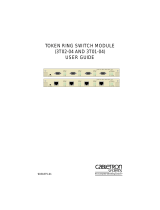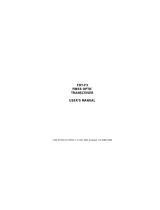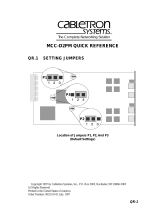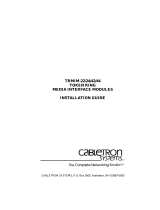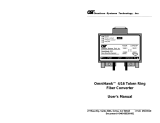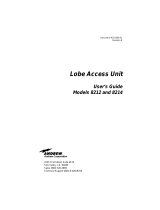Page is loading ...

MCC-16
TOKEN RING
MEDIA CONVERSION CENTER
USER’S GUIDE


i
NOTICE
Cabletron Systems reserves the right to make changes in specifications and other information
contained in this document without prior notice. The reader should in all cases consult Cabletron
Systems to determine whether any such changes have been made.
The hardware, firmware, or software described in this manual is subject to change without notice.
IN NO EVENT SHALL CABLETRON SYSTEMS BE LIABLE FOR ANY INCIDENTAL,
INDIRECT, SPECIAL, OR CONSEQUENTIAL DAMAGES WHATSOEVER (INCLUDING BUT
NOT LIMITED TO LOST PROFITS) ARISING OUT OF OR RELATED TO THIS MANUAL OR
THE INFORMATION CONTAINED IN IT, EVEN IF CABLETRON SYSTEMS HAS BEEN
ADVISED OF, KNOWN, OR SHOULD HAVE KNOWN, THE POSSIBILITY OF SUCH
DAMAGES.
Copyright 1997 by Cabletron Systems, Inc. P.O. Box 5005, Rochester, NH 03866-5005
All Rights Reserved
Printed in the United States of America
Order Number: 9032097-02 July 1997
Cabletron
,
SPECTRUM
and
LANVIEW
are registered trademarks of Cabletron Systems, Inc.
MIM
, and
MMAC
are trademarks of Cabletron Systems, Inc.
All product names mentioned in this manual may be trademarks or registered trademarks of their
respective companies.
FCC NOTICE
This device complies with Part 15 of the FCC rules. Operation is subject to the following two
conditions: (1) this device may not cause harmful interference, and (2) this device must accept any
interference received, including interference that may cause undesired operation.
NOTE
:
This equipment has been tested and found to comply with the limits for a Class A digital
device, pursuant to Part 15 of the FCC rules. These limits are designed to provide reasonable
protection against harmful interference when the equipment is operated in a commercial environment.
This equipment uses, generates, and can radiate radio frequency energy and if not installed in
accordance with the operator’s manual, may cause harmful interference to radio communications.
Operation of this equipment in a residential area is likely to cause interference in which case the user
will be required to correct the interference at his own expense.
WARNING
:
Changes or modifications made to this device which are not expressly approved by the
party responsible for compliance could void the user’s authority to operate the equipment.
Printed on Recycled Paper

NOTICE
ii
DOC NOTICE
This digital apparatus does not exceed the Class A limits for radio noise emissions from digital
apparatus set out in the Radio Interference Regulations of the Canadian Department of
Communications.
Le présent appareil numérique n’émet pas de bruits radioélectriques dépassant les limites applicables
aux appareils numériques de la class A prescrites dans le Règlement sur le brouillage radioélectrique
édicté par le ministère des Communications du Canada.
VCCI NOTICE
This is a Class A product based on the standard of the Voluntary Control Council for Interference by
Information Technology Equipment (VCCI). If this equipment is used in a domestic environment,
radio disturbance may arise. When such trouble occurs, the user may be required to take corrective
actions.
CABLETRON SYSTEMS, INC. PROGRAM LICENSE AGREEMENT
IMPORTANT
:
Before utilizing this product, carefully read this License Agreement.
This document is an agreement between you, the end user, and Cabletron Systems, Inc. (“Cabletron”)
that sets forth your rights and obligations with respect to the Cabletron software program (the
“Program”) contained in this package. The Program may be contained in firmware, chips or other
media. BY UTILIZING THE ENCLOSED PRODUCT, YOU ARE AGREEING TO BECOME
BOUND BY THE TERMS OF THIS AGREEMENT, WHICH INCLUDES THE LICENSE AND
THE LIMITATION OF WARRANTY AND DISCLAIMER OF LIABILITY. IF YOU DO NOT
AGREE TO THE TERMS OF THIS AGREEMENT, PROMPTLY RETURN THE UNUSED
PRODUCT TO THE PLACE OF PURCHASE FOR A FULL REFUND.

NOTICE
iii
CABLETRON SOFTWARE PROGRAM LICENSE
1. LICENSE
. You have the right to use only the one (1) copy of the Program provided in this
package subject to the terms and conditions of this License Agreement.
You may not copy, reproduce or transmit any part of the Program except as permitted by the
Copyright Act of the United States or as authorized in writing by Cabletron.
2. OTHER RESTRICTIONS. You may not reverse engineer, decompile, or disassemble the
Program.
3. APPLICABLE LAW. This License Agreement shall be interpreted and governed under the laws
and in the state and federal courts of New Hampshire. You accept the personal jurisdiction and
venue of the New Hampshire courts.
EXCLUSION OF WARRANTY AND DISCLAIMER OF LIABILITY
1. EXCLUSION OF
WARRANTY. Except as may be specifically provided by Cabletron in
writing, Cabletron makes no warranty, expressed or implied, concerning the Program (including
its documentation and media).
CABLETRON DISCLAIMS ALL WARRANTIES, OTHER THAN THOSE SUPPLIED TO
YOU BY CABLETRON IN WRITING, EITHER EXPRESSED OR IMPLIED, INCLUDING
BUT NOT LIMITED TO IMPLIED WARRANTIES OF MERCHANTABILITY AND
FITNESS FOR A PARTICULAR PURPOSE, WITH RESPECT TO THE PROGRAM, THE
ACCOMPANYING WRITTEN MATERIALS, AND ANY ACCOMPANYING HARDWARE.
2. NO LIABILITY FOR CONSEQUENTIAL DAMAGES. IN NO EVENT SHALL
CABLETRON OR ITS SUPPLIERS BE LIABLE FOR ANY DAMAGES WHATSOEVER
(INCLUDING, WITHOUT LIMITATION, DAMAGES FOR LOSS OF BUSINESS,
PROFITS, BUSINESS INTERRUPTION, LOSS OF BUSINESS INFORMATION, SPECIAL,
INCIDENTAL, CONSEQUENTIAL, OR RELIANCE DAMAGES, OR OTHER LOSS)
ARISING OUT OF THE USE OR INABILITY TO USE THIS CABLETRON PRODUCT,
EVEN IF CABLETRON HAS BEEN ADVISED OF THE POSSIBILITY OF SUCH
DAMAGES. BECAUSE SOME STATES DO NOT ALLOW THE EXCLUSION OR
LIMITATION OF LIABILITY FOR CONSEQUENTIAL OR INCIDENTAL DAMAGES, OR
ON THE DURATION OR LIMITATION OF IMPLIED WARRANTIES, IN SOME
INSTANCES THE ABOVE LIMITATIONS AND EXCLUSIONS MAY NOT APPLY TO
YOU.
UNITED STATES GOVERNMENT RESTRICTED RIGHTS
The enclosed product (a) was developed solely at private expense; (b) contains “restricted computer
software” submitted with restricted rights in accordance with Section 52227-19 (a) through (d) of the
Commercial Computer Software - Restricted Rights Clause and its successors, and (c) in all respects
is proprietary data belonging to Cabletron and/or its suppliers.
For Department of Defense units, the product is licensed with “Restricted Rights” as defined in the
DoD Supplement to the Federal Acquisition Regulations, Section 52.227-7013 (c) (1) (ii) and its
successors, and use, duplication, disclosure by the Government is subject to restrictions as set forth in
subparagraph (c) (1) (ii) of the Rights in Technical Data and Computer Software clause at 252.227-
7013. Cabletron Systems, Inc., 35 Industrial Way, Rochester, New Hampshire 03867-0505.

NOTICE
iv
DECLARATION OF CONFORMITY
Application of Council Directive(s):
89/336/EEC
73/23/EEC
Manufacturer’s Name:
Cabletron Systems, Inc.
Manufacturer’s Address:
35 Industrial Way
PO Box 5005
Rochester, NH 03867
European Representative Name:
Mr. J. Solari
European Representative Address:
Cabletron Systems Limited
Nexus House, Newbury Business Park
London Road, Newbury
Berkshire RG13 2PZ, England
Conformance to Directive(s)/Product Standards:
EC Directive 89/336/EEC
EC Directive 73/23/EEC
EN 55022
EN 50082-1
EN 60950
Equipment Type/Environment:
Networking Equipment, for use in a
Commercial or Light
Industrial
Environment.
We the undersigned, hereby declare, under our sole responsibility, that the equipment packaged
with this notice conforms to the above directives.
Manufacturer Legal Representative in Europe
Mr. Ronald Fotino Mr. J. Solari
___________________________________ ___________________________________
Full Name Full Name
Principal Compliance Engineer Managing Director - E.M.E.A.
___________________________________ ___________________________________
Title Title
Rochester, NH, USA Newbury, Berkshire, England
___________________________________ ___________________________________
Location Location

v
CONTENTS
PREFACE
CHAPTER 1 INTRODUCTION
1.1 MCC-16 Functional Overview......................................................1-2
1.1.1 Speed-Fault Protection...................................................1-3
1.1.2 Active Re-timing With Jitter Reduction Circuitry .............1-3
1.2 Conversion Modules....................................................................1-4
1.2.1 MCC-FRIO......................................................................1-4
1.2.2 MCC-DFL........................................................................1-4
1.2.3 MCC-CRIO .....................................................................1-5
1.2.4 MCC-D2PM ....................................................................1-5
CHAPTER 2 INSTALLATION
2.1 Installation Considerations ..........................................................2-1
2.2 Unpacking And Handling The MCC-16 .......................................2-2
2.3 Mounting The MCC-16 In A 19-Inch Rack...................................2-3
2.4 Unpacking And Installing The MCC-PS.......................................2-4
2.4.1 Power Supply LEDs........................................................2-5
2.4.2 Turning The MCC-16 On And Off...................................2-6
2.5 Unpacking A CM..........................................................................2-6
2.6 Installing A CM ............................................................................2-7
2.6.1 Boot-Up Sequence Of LEDs...........................................2-9
2.7 Resetting A CM ...........................................................................2-9
2.8 Attaching Cabling ........................................................................2-9
2.8.1 Connecting Twisted Pair Cabling..................................2-10
2.8.2 Connecting Fiber Optic Cabling....................................2-10
2.9 Determining The Station Count.................................................2-11
2.10 Troubleshooting The Network ...................................................2-12
2.10.1 Checking The MCC-16 .................................................2-12
2.10.2 Checking Lobe And Station Ports.................................2-12
2.10.3 Individual Station Problems ..........................................2-13
2.10.4 Checking RI/RO Ports ..................................................2-14
2.10.5 Checking The Entire Network.......................................2-15

CONTENTS
vi
CHAPTER 3 MCC-FRIO SETUP
3.1 Overview Of The MCC-FRIO.......................................................3-2
3.1.1 Token Flow......................................................................3-2
3.2 Setting Switches And Jumpers ....................................................3-3
3.2.1 Selecting The Ring Speed...............................................3-4
3.2.2 Selecting The Fiber Keying Type....................................3-4
3.3 LED Functions .............................................................................3-5
3.3.1 PWR - Power...................................................................3-5
3.3.2 16 Mb - Ring Speed ........................................................3-5
3.3.3 P1 And P2 - Ports............................................................3-6
3.3.4 RI And RO - Ports ...........................................................3-6
CHAPTER 4 MCC-DFL SETUP
4.1 Overview Of The MCC-DFL.........................................................4-2
4.2 Configuring The MCC-DFL ..........................................................4-3
4.2.1 Configuring The RJ45 Port As A Lobe
And The Fiber ST Port As A Station................................4-4
4.2.2 Configuring The RJ45 Port As A Station
And The Fiber ST Port As A Lobe...................................4-5
4.2.3 Configuring The RJ45 Port As RI
And The Fiber ST Port As RO.........................................4-6
4.2.4 Configuring The RJ45 Port As RO
And The Fiber ST Port As RI...........................................4-7
4.3 Selecting The Ring Speeds .........................................................4-8
4.4 Description Of Switches...............................................................4-9
4.4.1 Switch 1...........................................................................4-9
4.4.2 Switch 2...........................................................................4-9
4.4.3 Switch 3.........................................................................4-10
4.4.4 Switch 4.........................................................................4-10
4.5 LED Functions ...........................................................................4-11
4.5.1 PWR - Power.................................................................4-11
4.5.2 16 Mb - Ring Speed ......................................................4-11
4.5.3 P1 And P2 - Ports..........................................................4-12

CONTENTS
vii
CHAPTER 5 MCC-CRIO SETUP
5.1 Overview Of The MCC-CRIO......................................................5-2
5.1.1 Token Flow .....................................................................5-2
5.2 Setting Switches And Jumpers....................................................5-3
5.2.1 Selecting The Ring Speed..............................................5-4
5.2.2 Setting Port Configurations.............................................5-4
5.3 LED Functions.............................................................................5-6
5.3.1 PWR - Power..................................................................5-6
5.3.2 16 Mb - Ring Speed........................................................5-6
5.3.3 P1 And P2 - Ports...........................................................5-7
5.3.4 RI And RO - Ports...........................................................5-7
CHAPTER 6 MCC-D2PM SETUP
6.1 Overview Of The MCC-D2PM.....................................................6-2
6.1.1 Token Flow .....................................................................6-3
6.2 Setting Jumpers To Configure The CM.......................................6-3
6.2.1 Joining The D2PM Into One Ring...................................6-3
6.2.2 Selecting The Ring Speed(s)..........................................6-4
6.2.3 Summary Of Jumper Settings.........................................6-5
6.3 LED Functions.............................................................................6-5
6.3.1 PWR- Power...................................................................6-6
6.3.2 2 Rings - CM Split...........................................................6-6
6.3.3 16 Mb - Ring Speed(s)....................................................6-6
6.3.4 P1, P2, P3, And P4 - Ports .............................................6-6
APPENDIX A SPECIFICATIONS
A.1 Environmental Requirements......................................................A-1
A.2 Hardware Specifications..............................................................A-1
A.3 MCC-PS Power Supply Specifications........................................A-2
A.4 Regulatory Compliance...............................................................A-2

CONTENTS
viii
APPENDIX B CABLING
B.1 Trunk Cabling.............................................................................. B-1
B.2 Lobe Cabling............................................................................... B-2
B.2.1 Lobe Port........................................................................ B-2
B.2.2 Station Port.....................................................................B-2
B.3 Requirements And Recommendations .......................................B-2
B.3.1 Network Performance Requirements.............................. B-3
B.3.2 Signal Interference.......................................................... B-3
B.3.3 Determining The Maximum Signal-Drive Distance.........B-4
B.4 Cable Pinouts.............................................................................. B-4
B.4.1 Station Port Pins.............................................................B-4
B.4.2 Lobe Port Pins................................................................ B-5
B.4.3 RI Port Pins..................................................................... B-6
B.4.4 RO Port Pins................................................................... B-6
B.5 Connecting To An IBM Patch Panel ...........................................B-7
APPENDIX C MEDIA SPECIFICATIONS
C.1 Twisted Pair Copper Cable.........................................................C-1
C.1.1 UTP.................................................................................C-1
C.1.2 STP.................................................................................C-2
C.2 Fiber Optic Cable Specifications.................................................C-3
C.2.1 Multimode.......................................................................C-3
C.2.2 Single-Mode....................................................................C-3
INDEX

ix
PREFACE
Welcome to the
Token Ring Media Conversion Center (MCC-16)
User’s Guide
. This manual describes the capabilities and features,
operating specifications, installation, and troubleshooting procedures of
Cabletron Systems MCC-16 Media Conversion Center.
DOCUMENT CONVENTIONS
The following conventions are used throughout this document:
Bold Italics
are used to
reference Cabletron Systems documents and other
publications.
NOTE
Note
calls your attention to information of special importance.
TIP
Tip
gives you a helpful hint concerning procedures or actions.
!
CAUTION
Caution
calls your attention to information essential to avoid
damage to the equipment, or network configuration settings.
Warning
calls your attention to an action that could result in
the presence of an electrical shock hazard.

PREFACE
x
USING THIS MANUAL
Prior to installing and operating the MCC-16, read this manual
completely to become familiar with its contents and the features of the
MCC-16. This manual assumes the reader has a general working
knowledge of Token Ring (IEEE 802.5) networks.
The manual is organized as follows:
Chapter 1,
Introduction
, provides an overview of the features and
capabilities of the MCC-16 and CMs, and describes the power supplies.
Chapter 2,
Installation
, describes the installation of the MCC-16 chassis
into a 19-inch rack, an MCC-PS power supply into the MCC-16, a CM
into the MCC-16, and cabling into CM ports. The chapter also details the
maximum cable lengths, the maximum station count, and troubleshooting
procedures that can isolate problems.
Chapter 3,
MCC-FRIO Setup
, describes how to configure the
MCC-FRIO CM and explains its LEDs.
Chapter 4,
MCC-DFL Setup
, describes how to configure the MCC-DFL
CM and explains its LEDs.
Chapter 5,
MCC-CRIO Setup
, describes how to configure the
MCC-CRIO CM and explains its LEDs.
Chapter 6,
MCC-D2PM Setup
, describes how to configure the
MCC-D2PM
CM and explains its LEDs.
Appendix A,
Specifications
, describes the specifications of the MCC-16,
the CMs, and the MCC-PS power supply.
Appendix B,
Cabling
, details cabling specifications, provides
recommendations to optimize network performance, defines signal
assignments for port pins, and illustrates pinouts to connect to an IBM
patch panel using MIC.
Appendix C,
Media Specifications
, discusses the design and
performance specifications for different media types used in Token Ring
networks.

PREFACE
xi
RECOMMENDED READING
The following publications are recommended if more information is
required regarding the implementation of Token Ring networks.
Local Area Networks
,
Token Ring Access Method
, IEEE Standard 802.5
(1989)
Commercial Building Telecommunication Cabling
,
No. EIA/TIA-568
TECHNICAL SUPPORT
If you need additional support related to this device, or if you have any
questions, comments, or suggestions concerning this manual, contact the
Cabletron Systems Global Call Center:
Before calling the Cabletron Systems Global Call Center, have the
following information ready:
•
Your Cabletron Systems service contract number
•
A description of the failure
•
A description of any action(s) already taken to resolve the problem
(e.g., changing mode switches, rebooting the unit, etc.)
•
The serial and revision numbers of all involved Cabletron Systems
products in the network
•
A description of your network environment (layout, cable type, etc.)
•
Network load and frame size at the time of trouble (if known)
Phone (603) 332-9400
Internet mail suppor[email protected]
FTP ctron.com (134.141.197.25)
Login
anonymous
Password
your email address
BBS (603) 335-3358
Modem setting 8N1: 8 data bits, No parity, 1 stop bit
For additional information about Cabletron Systems or our products,
visit our World Wide Web site:
http://www.cabletron.com/
For technical support, select
Service and Support
.

PREFACE
xii
•
The device history (i.e., have you returned the device before, is this a
recurring problem, etc.)
•
Any previous Return Material Authorization (RMA) numbers

1-1
CHAPTER 1
INTRODUCTION
The MCC-16 Media Conversion Center is a 16-slot modular chassis that
holds up to 16 Conversion Modules (CMs). The MCC-16, shown in
Figure 1-1, can change twisted pair switch ports to different ports and/or
media types. It is designed for switches and can convert between Ring In
(RI), Ring Out (RO), lobe, and station ports, using twisted pair or
multimode fiber optic cabling.
The MCC-16 accommodates four different CMs. Each CM can support at
least two lobe ports which allow the connection of station ports,
commonly on switches. The MCC-16 is IEEE 802.5 and IBM compliant.
The conversion modules are discussed in Section 1.1 and Section 1.2.
Figure 1-1 The MCC-16 Media Conversion Center
MCC-16
MCC-DFLMCC-DFLMCC-DFLMCC-DFL
MCC-FRIOMCC-FRIOMCC-FRIOMCC-FRIOMCC-D2PM MCC-CRIO MCC-CRIO MCC-CRIO MCC-CRIOMCC-D2PM MCC-D2PM MCC-D2PM

INTRODUCTION
1-2
1.1 MCC-16 FUNCTIONAL OVERVIEW
The MCC-16 Media Conversion Center holds up to 16 CMs. The CMs
(listed in Table 1-1) can be used in any combination to accommodate
various types of Token Ring connections.
The MCC-16 features:
•
Compatibility with all Token Ring IEEE 802.5 compliant devices.
•
Ability to operate at 16 Mbps or 4 Mbps ring speeds.
•
Auto-sensing RJ45 ports that accept both Shielded Twisted Pair (STP)
and Unshielded Twisted Pair (UTP) cabling.
•
Active Re-timing with Jitter Reduction Circuitry that effectively
reduces jitter.
Table 1-1 Port And Media Type Of Conversion Modules
Type of Ports on the CM
Conversion
Module (CM)
Twisted Pair
(RJ45 Ports)
Multimode Fiber
(ST Ports)
See
Chapter
Below
For More
Information
MCC-FRIO
(Fiber
Ring In/Out)
Two lobe ports
One set RI/RO
ports
Chapter 4
MCC-DFL
(Dual Fiber
Link)
Two configurable
ports (station,
lobe, RI, or RO)
Two configurable
ports (station,
lobe, RI, or RO)
Chapter 5
MCC-CRIO
(Copper
Ring In/Out)
Two lobe ports
One set RI/RO
ports
Not applicable Chapter 6
MCC-D2PM
(Dual 2-Port
MAU)
Four lobe ports Not applicable Chapter 7

INTRODUCTION
1-3
•
Speed-fault protection that prevents stations from causing a beaconing
condition when entering the ring at the wrong speed.
•
Dual load-sharing, fully redundant power supplies.
•
CMs and power supplies that can be installed or removed without
interrupting the operation of the other CMs and power supply in
the MCC-16.
•
Support for any combination of interchangeable CMs to provide
flexibility in choosing media types accommodating a wide variety of
topologies.
•
Integrated rack-mount brackets that allow the MCC-16 to install into
any 19-inch rack.
•
Autowrap feature on RI/RO ports that disables the appropriate port if
the cable is disconnected or fails – preserving ring integrity.
•
LANVIEW LED system that reports the status of the physical layer.
1.1.1 Speed-Fault Protection
The CMs prevent any device from entering the ring at the wrong speed by
wrapping (closing) the port to which the device is trying to insert. This
prevents the device from beaconing the ring.
1.1.2 Active Re-timing With Jitter Reduction Circuitry
Active Re-timing with Jitter Reduction Circuitry uses a dual-digital,
Phase Lock Loop (PLL) that utilizes First-In, First-Out (FIFO) processing
to track and accurately receive even poor quality signals. This circuitry
effectively reduces jitter on a ring and removes jitter budget restraints.
This permits the use of longer cable lengths and mixed media types
without penalty and supports 250 stations per ring.

INTRODUCTION
1-4
1.2 CONVERSION MODULES
Each CM has at least two RJ45 receptacles that can be used for attaching
the cable from a Token Ring station, such as a switch. CMs that have
RI/RO capability allow the connection of RI ports to RO ports
(and vice versa) on other devices to extend the ring. The RI/RO ports are
compatible with all 802.5 compliant devices including passive MAUs.
By using different CMs in the MCC-16, the installation can contain RI,
RO, lobe, and station ports of either multimode fiber or twisted pair cable
to meet the needs of almost any topology.
1.2.1 MCC-FRIO
The MCC-FRIO, with RI/RO capabilities, has a set of fiber
ST RI/RO ports that can connect to RI/RO ports on other devices
(e.g., TDRMIM-AT, TRFOT-2, or TRRMIM-4AT) to extend the ring. The
module also has two lobe ports to connect stations. Thus, stations
connected to either lobe port can communicate across the RI/RO
connections to other parts of the ring, and they will also communicate
with each other.
1.2.2 MCC-DFL
The MCC-DFL has two Fiber Optic Transceivers (FOTs). Each FOT has a
twisted pair and fiber ST port. This allows signals transmitted over the
twisted pair to be converted into optical signals for transmission over
multimode fiber. You can configure each FOT as a RI/RO device or a
station/lobe device. A switch can be set so that connections can be made
to an 802.5J compliant device.
NOTE
The MCC-16 backplane supplies the power for the CMs. Each
CM provides media conversion and/or port-type switching per
module.
NOTE
Cabletron Systems offers complete compatibility with vendor
products that comply with the “new” 802.5J standard for fiber
RI/RO ports. Therefore, the MCC-16 offers connectivity to
products using 802.5J or Cabletron Systems fiber keying.

INTRODUCTION
1-5
1.2.3 MCC-CRIO
The MCC-CRIO has a set of twisted pair RI/RO ports that can connect to
other devices with RI/RO capability (e.g., TDRMIM-AT). It also has two
lobe ports. This allows for RI/RO connections and the connection of
two stations. It provides the same functionality as the MCC-FRIO
(see Section 1.2.1) except it has twisted pair RI/RO ports.
1.2.4 MCC-D2PM
The MCC-D2PM can serve as a pair of two-port Multi-Station Access
Units (MAUs) or a single four-port twisted pair MAU.

INTRODUCTION
1-6
/



